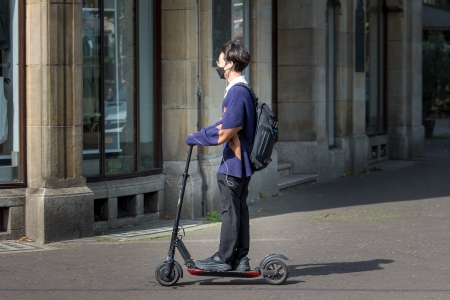As yet, little is known about the safety of LEVs. In the Netherlands and most other countries, LEVs that are allowed on public roads have not yet or only recently been included as a distinct vehicle category in crash registrations. In the Netherlands, no LEVs whatsoever have yet been registered as a distinct vehicle category. In Belgium, they have recently been included in the crash registration. The data that we do have, originate from small-scale foreign research and mostly concern hospital treatments after e-scooter crashes; these data do not include information about crashes involving other LEV types. Not much can be said about the crash risk of e-scooters; the safety per distance travelled. Slightly more is known about the type of injury incurred in e-scooter crashes and about other crash characteristics, such as user type and the crash type most prevalent among e-scooter users.
Crash risk
Recent German research shows that the number of e-scooter crashes per billion kilometres is 4.5 times larger than that of bicycle crashes, i.e. 5.5 and 1.2 respectively [16]. The number of serious injury crashes per billion kilometres travelled was almost five times higher (0.18 for bicycles versus 0.88 for e-scooters). On the basis of Norwegian research, the number of e-scooter versus bicycle crashes per billion kilometres is estimated to be 89 and 8 respectively [17]. It should be noted, however, that the number of crashes will probably decrease over time because of increased experience with e-scooters. This is apparent from data from the United States, where e-scooter sharing systems have been operational since 2017 [11]. Previously, US data have also been used to assess crash risk, albeit per journey and not per distance travelled. Comparing the number of fatal bicycle crashes to fatal e-scooter crashes, the US report concludes that the fatality risk per journey is the same. This also goes for the risk of needing ER care. Comparing e-scooters to bicycles, the risk of hospitalisation, however, is greater for e-scooter riders [11]. On the basis of the same research data, a recent report by KiM Netherlands Institute for Transport Policy Analysis estimates the risk of a fatal crash per distance travelled to be higher for e-scooters than for bicycles [18].
Injuries
Most hospital studies [19] [20] [21] [22] [23] [24] [25] [26] [27] show that the largest number of injuries are to the head (including the face), followed by injuries to the (upper) limbs (hands, wrist, arm, shoulder). They also show that by far most casualties with head injuries did not wear helmets. Only very few casualties of e-scooter crashes die, but a significant number of them need surgery or even end up in intensive care units.
Casualties
Young men (aged 20-40), first-time e-scooter users and occasional users are most often involved in crashes [20] [28] [29]. Research also shows that in a significant number of crashes (about 30%), the e-scooter user was under the influence of alcohol [21] [30] [31] [32] [33].
Crash type
In most e-scooter crashes, no other vehicle is involved. A Norwegian questionnaire survey shows that the road surface quality (slipperiness, tram tracks, potholes) is a common cause of single-vehicle (near miss) crashes [17]. If the crash involves a conflict with other road users, these are most often pedestrians and cyclists. Injuries are usually most severe when a motorised vehicle is involved in the crash. On average, in more than 80% of fatal e-scooter crashes, a heavier motorised vehicle is involved [11].
Time of crash
A number of studies show that the greatest proportion of e-scooter crashes occur in the evening, at night and in weekends [23] [34]. But these results vary among studies and locations [20].
Risk to pedestrians
In some countries, e-scooters can be used on pavements, as for example in Belgium, Finland and Sweden. But e-scooters quite often also ride on pavements where this is not allowed. For pedestrians, e-scooters on pavements are risky [20] [35], particularly because of the difference in speed (sometimes, in combination with a difference in mass, and because of the material the e-scooters are made of). In addition, these vehicles hardly produce any sound and have no readily visible lighting, sometimes even no lighting at all, which makes them harder to see. For older, hearing- or sight-impaired pedestrians this makes it harder to adequately anticipate this kind of vehicle [36]. Moreover, the way the e-scooters are parked causes problems, because most e-scooter sharing systems have no dedicated parking spaces or charging stations. For this reason they often block the pavement, which could lead to unsafe situations (pedestrian stumbles or falls).
